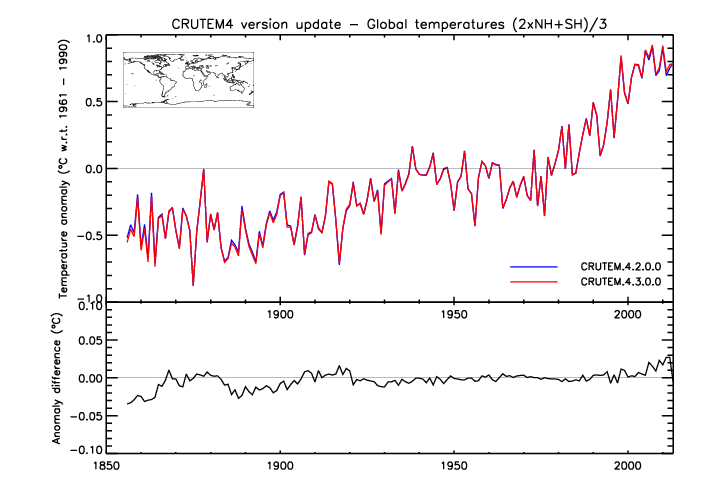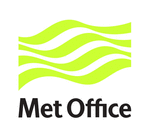
| Met Office Hadley Centre observations datasets |
| > Home > CRUTEM4 > Versions > |
This page describes updates in CRUTEM4 version CRUTEM.4.3.0.0. Previous versions of CRUTEM4 can be found here. Data for CRUTEM.4.3.0.0 can be found here.
Principal additions to the CRUTEM archive (post-CRUTEM.4.2.0.0), within the period May 2013 to May 2014 are listed below:
In addition there have been some corrections of errors. These are random in nature and are normally done using manual edit.
There are 22 homogenized climate series (Tmax and Tmin) in the SDATS archive which were acquired through personal communication. The series start between 1850 and 1903 and currently run to the end of 2012. For full details of the dataset, see Brunet et al. , 2006, DOI: 10.1002/joc.1338. After initial processing and the production of Tmean from (Tmax+Tmin)/2), the 22 series were added to CRUTEM using blanket overwrite of any existing matches in CRUTEM. This resulted in a gain of ten Spanish series for the archive.
For two of the series (Soria and Salamanca), the Tmean series were further extended using data from Climatic Research Unit (CRU) existing monthly archives which started at an earlier date than the Tmax and Tmin series from SDATS. Homogeneity adjustments for the new additions to the two series were taken from the homogeneity adjustments used in the SDATS homogenizing processes run by Brunet et al. The result was that both series were extended back to 1866. However, on the application of a new homogeneity test, the first reliable year (FRY) flag was retained as 1893 for Soria.
The two subsets of homogenized series came from different sources. The 18 long homogenized monthly mean series (Cao et al., 2013, DOI: 10.1002/jgrd.50615) have been acquired through personal communication and added to the CRUTEM archive. Due to the extensive work that has gone into the construction and homogenization of the 18 series, priority was given to these over any matching series in the larger 380-subset (below,) when the merger with CRUTEM was conducted. The longest series is that for Shanghai which begins in 1873.
The second, much larger subset of 380 homogenized series, most of which cover the period 1950s to 2012 (none start earlier than 1951), have been prepared by Xu et al. (2013, doi:10.1002/jgrd.50791). The daily series, acquired through personal communication, were used to produce monthly-mean series. Before any merger between the two new subsets (combined) and the CRUTEM archive was actually undertaken, checks were made to see if any of the new series received had data in the existing CRUTEM archive under different ID codes. As a result of these checks, six of the existing CRUTEM series were combined (merged) with the new matching series (under the new ID codes). The final merger with CRUTEM archive, using blanket overwrite, resulted in there being 419 Chinese series in CRUTEM. This is a significant increase of 250 series from the previous update in 2013.
Checks were made on any post-merger series that had retained original CRUTEM (pre-merger subset) blocks of data - that is, before the start of the homogenized series being added. As a result of these checks, inhomogeneity was apparent in five series. Three of these were corrected via the use of the same adjustments used by the creators of the homogenized series and two series received FRY labels that effectively inactivate their pre-homogenized series section.
During the preceding operations, it was noted that the Station series for Hong Kong (one of the 18 long series), under the ID code 450050, no longer receives routine updates from monthly circulations. The ID code for Hong Kong is now 450040. The CRUTEM station ID for Hong Kong was thus changed to the new value.
A repeat of the actions taken in recent years updated the United States Historical Climatology Network (USHCN) series in CRUTEM. That is, the latest data file (25th March, 2014 version of ushcn.tavg.latest.FLs.52i.tar) was downloaded from http://cdiac.ornl.gov/ftp/ushcn_v2.5_monthly/ . The same series (1218) were updated as in the previous such exercise in 2013. Following the merger with CRUTEM, which updated the series to March 2014, checks were run to look at the homogeneity of any post-merger series that have retained pre-USHCN blocks of data. As a result of this, 17 of the combined post-merger series were allocated FRY codes that do not match their first year of data. This effectively inactivates their early subsets that appear to have homogeneity problems. No new series were added as a result of the final merger.
Updates to and including October 2013, for most of the 518 series (the same stations as in the previous such exercise in January 2012), were obtained from http://meteo.ru/english/climate/d_temp.php . No new station series were added by the merger with CRUTEM.
Updates to the 112 ACORN climate series (as Tmax and Tmin) were downloaded from http://www.bom.gov.au/climate/change/acorn-sat/ . The network of stations has remained the same since the previous exercise in July 2012. Following the merger of the updates as Tmean (Tmax+Tmin)/2 , to the end of 2013, there was no need to check the homogeneity status of any post-merger pre-ACORN blocks of data since the ACORN series were unchanged with respect to the previous exercise - except for updates being added.
In addition, following the receipt of information that there is a problem in one or more of the 'Australian remote islands' series (added November 2012), checks were made. The specific query referred to Lord Howe Island, but all others were checked. It was found that there had been an error in the previous processing operation. Operations were re-run and the problems corrected. New versions of the eight series were re-merged with CRUTEM.
The holdings of homogenized series at the eKlima portal were checked as a follow up to the initial exercise in July 2012. It was found that no routine updates had been made but five new or extended/modified series were downloaded and processed. In the final (blanket overwrite) merger, no new stations were added to CRUTEM since the series new to eKlima were already present under source code "54". The most significant gain in terms of length of series was for the high Arctic station Svalbard Airport which has been extended back in time to 1898 (see http://www.polarresearch.net/index.php/polar/article/view/21349).
Following the discovery that a CRUTEM 5x5° grid box in Sweden (centred at 62.5°N and 17.5°E) had no reporting station in recent years, the availability of potential series within the grid-box was checked using the resources of the European Climate Assessment and Dataset (ECA&D). The blended archive of Swedish series was downloaded and processed. Three series were chosen (by their location and length of record) and incorporated into CRUTEM by merger.
A long series (1895-present), for Mount Pleasant Airport has been constructed - see Lister and Jones, 2014, DOI: 10.1002/joc.4049. While this is only a single series, it is in a part of the world that has few long climate series.
After the processing of a number of monthly series for India, which cover the period approximately 1901-mid/lat-1980s and which had been in the possession of the Climatic Research Unit (CRU) for a number of years, 85 station series were assessed for their potential inclusion in CRUTEM. Before any merger with CRUTEM was undertaken the number of Indian series present and eligible for gridding operations was around 50. Of the 85 series present in the 'new' subset, a number of these (35) were matched with existing series. This reveals the potential for 50 new Indian series in CRUTEM to improve areal and temporal station densities. However, a comparison of the overlap monthly values for the matching series revealed a number of issues.
Patterns seen in blocks of differences showed that adjustments had been made to some of the series, CRUTEM or the new subset, in the interests of homogenizing compound series. Where these could not be accounted for in the new series, these were removed from any merger plan. However, where differences could be accounted for in the new series, appropriate adjustments were made so that the new series could be used, if necessary, to infill/extend existing CRUTEM matches. The final subset of 73 new series (some now adjusted) was merged with CRUTEM. This added 50 series to CRUTEM but all ending by the mid/late 1980s.
Two sources of Chilean data have been used. Firstly, seven long monthly series were processed from some CRU files (as with India, above). As with the Indian series, these series run approximately from the earlier part of the 20th Century to 1988. The second source of Chilean series is from the CLARIS Project (http://www.claris-eu.org/). The studies of the La Plata Basin accessed some Chilean daily series. The downloading facility can be found at: http://wp32.at.fcen.uba.ar/stations/temperature. Ten monthly series, covering the period approximately 1967-2005, were processed for potential inclusion in CRUTEM. After assessment for suitability and some rationalization of the two subsets of Chilean series, 16 series were merged with CRUTEM, the stations coming from CLARIS sources having pseudo-WMO codes. It should also be noted that series coming from CLARIS sources have Tmean calculated as (Tmax+Tmin)/2. Most of the countries in South America use different formulae to calculate Tmean.
Following the merger with CRUTEM, simple homogeneity checks were run and no problems were apparent. In addition, three Chilean series for unnamed locations (source code "30") which have not updated in CRUTEM since the early 1990s were rendered inactive by the allocation of suitable FRY codes.
The following updates have been made to the monthly update system:
The following diagnostic plots show comparisons of global and hemispheric time series for CRUTEM.4.3.0.0 and CRUTEM.4.2.0.0.
Commercial and media enquiriesYou can access the Met Office Customer Centre, any time of the day or night by phone, fax or e-mail. Trained staff will help you find the information or products that are right for you. |
 |
Maintained by: Colin Morice |
© Crown Copyright |